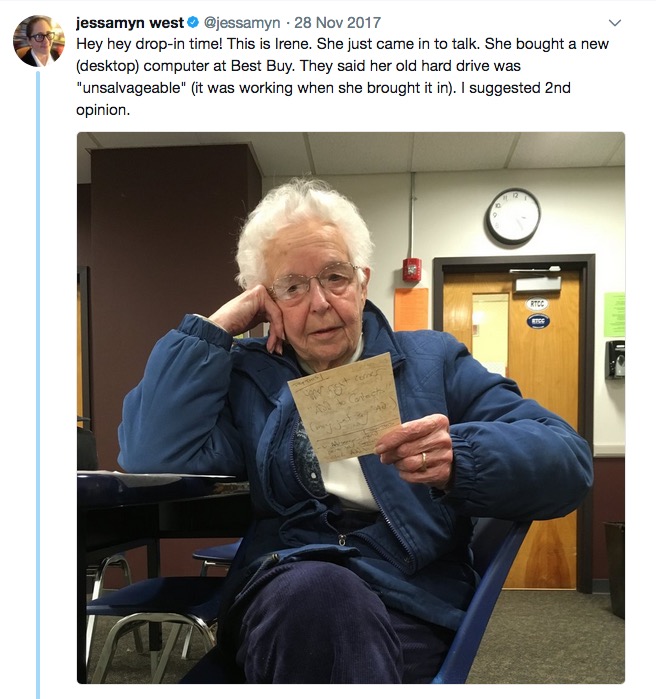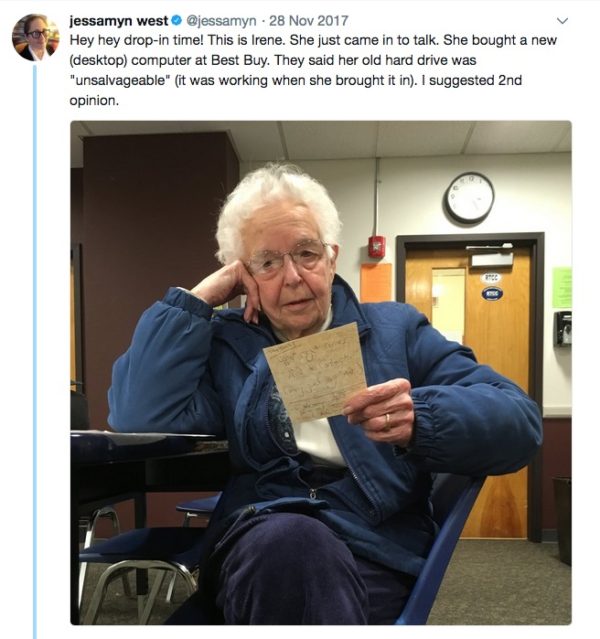Excerpt from an email from a librarian in the Midwest: One of the goals for the new [library] strategic plan is that “Patrons will find support and expertise in technology instruction.” I’ve never taught classes before but I do like to mess around with technology.
I don’t know if it is my perception or not, but your drop-ins seem like a great community building atmosphere where disparate characters can come together and learn about tech and get help. I’d love to know how you have designed/fostered their growth.
I do drop-in time work within the context of a technical high school not the public library, just as an FYI. I started there ten years ago after my last library job had ended (it was grant funded) and I was like “I am taking some time off and will not take a job unless I open the paper and there is a ‘teach email to old people’ job listed…” and well, there was! The vocational school was hiring a VISTA volunteer to help with community tech work. Basically it’s a regional school so all the “sending towns” send kids and money to the school but don’t get as much back as the town that houses the school. So we thought about how to fix that.
In the early days it was three separate things:
- visiting tech help to small libraries (I got mileage paid by the school and hours were part of the VISTA program). Show up max twice a month and help them with whatever. This was maybe eight small libraries, some became regulars some were not
- teaching adult ed classes
- drop-in came as a result of these classes
We found that there were people signing up to take the Intro To Computers class, for example, who didn’t know how to use a mouse. And… how were they going to learn? So we set up drop-in time as a way for people who needed a little extra help (since Adult Ed classes pay by the hour, teachers aren’t paid to come early or stay late) or if we needed someone to evaluate if someone had enough of the skills they needed to take a class. And what we found was a lot of people didn’t NEED a class, they just needed someone to help them get their login working, or sign up for an email address and then they were good. At first we did it two afternoons a week, then it got dropped to one after the VISTA position ended. The funding right now comes from some of the money that comes in from both the Department of Labor and Department of Ed. The school offers space, admin time, some laptops that people can use, free (filtered, but not heavily filtered) wifi, heat or AC, and places to plug in computers. Clean restrooms. People can bring their dogs. There’s a whiteboard and an overhead but I barely use them. It’s really mostly tables and chairs.
A few things we do as part of our thing
- Sometimes Vocational Rehab will send someone to drop-in to “learn computers” as part of work-related activities, this works out well usually
- A lot of people are “regulars” and they just like coming to work in a setting where they know someone is there in case they hit a wall
- It’s a small community there, a lot of people know each other at least a little
- I have a local kid who is 14 and comes to help out because it’s interesting and he’s super smart but doesn’t have the best people skills. We work on his people skills and people are very forgiving/understanding since the help is free
- I sometimes do some low-level teaching at the school for continuing ed (“Help us learn to use Google Classroom” types of things)
- We have sign up lists so we track basic stats but not more than that
And a few oddball things:
- If people need one on one help, we have a computer shop in town or I will sometimes meet people at the coffee shop and they can put money on my tab (I do not advertise this)
- under NO circumstances do we do house calls
- I’ll help people with basic stuff over email, I do not take phone calls
We used to offer coffee and snacks and found there wasn’t much uptake. We stress that it’s NOT A CLASS “just an opportunity for learning” I get paid like $20-25/hour (depending on funding sources) for when I am there, so total cost for the program is basically $50/week and I work probably ~30 weeks a year (we take summers off, NO ONE came when we were there in Summers). It’s very fundable assuming you have a place with loaner laptops.
A lot of what I do lately, as you can see, is help people with a lot of basic stuff: Apple ID, iTunes, their phones, using a new website, buying/selling things, downloading an ebook or music. Sometimes they need to buy a thing and want advice. Sometimes Facebook confuses them (rarely Twitter or Instagram). Sometimes it’s digital photography or software apps but not so much lately. Some things that are challenging are when people have questions about their printers or at-home desktop computers or “how do I make a backup?” and you have to sort of talk them through what to do when they get home. A lot of people have ANCIENT technology and while some of them could be gently encouraged to buy something newer, most are dealing with what they can afford, so having practical solutions that aren’t just “Buy new shit!” is helpful. Attitude is a lot of it. People mention often how patient I am. I am not necessarily a patient person but patience is effective so I use it.
A big thing is that it’s clear that drop-in, and me, are a shared resource. I encourage people to come with projects or questions. I make it clear that I deal with people first-come first-served and spend time “circulating.” This often encourages people to speak with each other even though I never would have considered this something I intentionally did. People who are inclined to come to something like this are, I think, a little bit more community-minded than folks who just sit at home and swear at their computer (or make promises they’ll get to it “someday”) so it does self-select. Which is one reason I am in favor of this model even though I know a lot of libraries who do a “schedule time with an expert” thing which is another way of managing it but maybe not as community-minded. We advertise in all the usual places. Getting on the regular calendar in the newspaper has been helpful. Nearly all of it nowadays is word of mouth. I’ve been doing this for ten years.
So this is top of the head stuff. If you have specific questions or something I didn’t address, do let me know.


Thank you for sharing the background behind drop-in time, Jessamyn. I really enjoy reading about it on Twitter whenever you have it.
“I am not necessarily a patient person but patience is effective so I use it.”
This is absolutely genius, and I think maybe a life-changing concept.
Ten years! I’d love to offer this once a week. We do a once a month with high school volunteers, people love it, but some months no one comes, some months everyone comes.